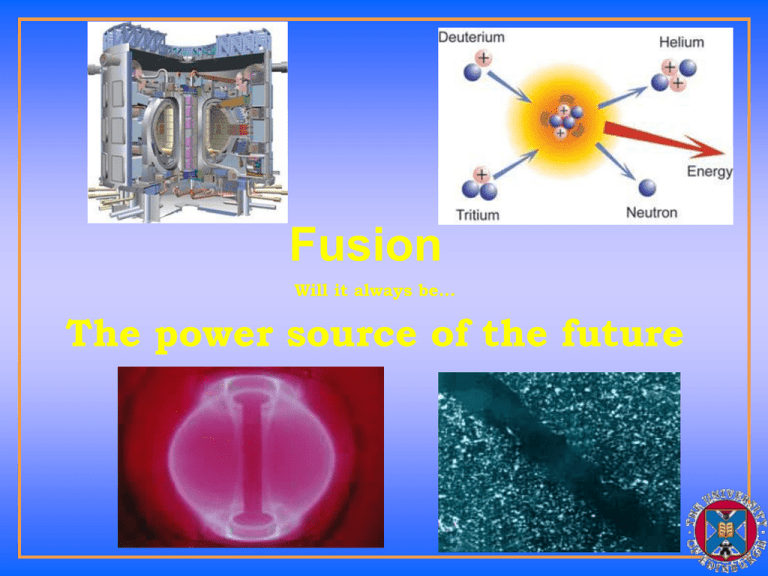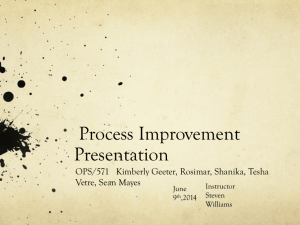Fusion The power source of the future Will it always be…
advertisement

Fusion Will it always be… The power source of the future Plasma in spherical tokamak START TOKAMAK Ten times the temperature of the sun ITER – the Way Caderache, France, Open 2016 500Mw 400 seconds ITER - costs Current estimate total €5 billion (JET on budget) Double LHC, Half SSC (at cancellation) 10% Space Station Indicative Single-year EU subsidies to existing generation methods 2001 (European Environmental Agency, 2004) Coal €13 billion Oil/gas €8.7 billion Nuclear €2.2 billion Renewables €5.3 billion Making electricity Energy is primarily contained in neutrons, alpha particles. Capture these in a “blanket”, heat up water, sodium, Pb etc. Heat exchanger to run a steam engine. None of this will be done at ITER. Next Machine, DEMO, will make power DEMO – Non-commercial power generation Materials Plasma facing material First wall Blanket Material Reaction pressure vessel Electronics… Magnets… Challenges for fusion materials technology •Low Activation – decommissionability •Very high heat loads for materials facing the plasma •Damage to the structure caused by high-energy neutrons •Production of tritium in situ •Helium embrittlement •Sputtering on surface & poisoning of plasma by heavy ions Radiation Damage Simulations Radiation damages the materials from which a reactor is made. This determines reactor lifetimes. A non-equilibrium process, it has unknown scaling with time and dose. Modelling required. Edinburgh: Graeme Ackland and Derek Hepburn First principles studies of “primary damage” (point defects). Simplified atomistic force models for metals. Molecular dynamics of evolution of damage, and emergent objects (dislocation loops, hardening, voids, etc.) Previous Edinburgh Funding: Four EU FP6/7 PDRA grants with various industrial partners (EDF, SCK, FZK) ITEM, PERFORM, PERFECT, GETMAT One EPSRC PDRA joint with Culham & Oxford Total value to Edinburgh ~£500,000 SUPA funding: none. Dynamical system Radiation in Defects produced Defects recombine or migrate to sinks Sinks grow (voids lead to swelling) and may saturate (grain boundary segregation) Not at Thermodynamic Equilibrium Voids in Si after 10keV a irradiation •Vanadium swells (vacancies form voids) •V + Fe brittle, doesn’t swell •V + Fe + Cr neither - but why? International Fusion Materials Irradiation Facility (IFMIF) Environments – First Wall Bombarded by 14MeV neutrons (alphas are contained by magnetic field). At 500oC for commercial reactor. 200 dpa (five year lifetime) Immune to radiation damage in presence of He. Immune to transmutation to long lived isotopes. Weldable, formable, corrosion resistant etc. etc. Must not poison plasma, sputter Candidates – First Wall Vanadium (+Cr,Ti). Ferritic/Martensitic Stainless Steel (FeCr) Oxide Dispersion Strengthening (ODS) SiC Diamond coating Environment - Blanket Immediately behind the first wall Protect the magnets from radiation (ITER) Convert neutron energy to heat (DEMO) Produce tritium for reaction (DEMO) Liquid – avoid damage – water, LiPb Environment – Pressure Vessel Contain coolant Resist neutron bombardment High temperature Stainless steel Multiscale modelling of fusion materials •Engineering properties depend on •microstructures that depend on •properties of defects that depend on •interatomic interactions that depend on •electronic structure of the material How materials deform Creep – 0D (point defects) My Video\nhcreep[1].mov Dislocations – 1D (line defects) My Video\dislox[1].mov Edinburgh Speciality: Interatomic potentials Computational elegance -Want force on atoms as a function of atomic degrees of freedom only. Simulate billions of atoms (microns) Use insight from quantum mechanics – beyond pair potentials Energy as a functional of pairwise interactions Fit parameters of the functional to relevant properties of the material (phase diagram, defect formation etc) Atomistic simulations Interstitial defects in body-centred cubic Fe <110> diffuses slowly, <111> quickly Not an atom moving - Impurities pin defects. Radiation Damage When radiation hits metal – one atom acquires enormous energy. 3D billiards with a million balls Empty site – vacancy (red) Doubly-occupied site – interstitial (green) Clustering Cu 25keV cascade 100K 74FP.mov Vacancies - the theory of nothing Vacancies cluster near initial event 3D void But … a 3D void comprising vacancies can collapse to form a 2D platelet Or, if top and bottom of platelet match, the only defect is a 1D loop around the edge. Vacancies are not conserved How to describe material transport? Emergent interstitial features Interstitials form 2D platelets (anisotropic strain). But these are really 1D dislocation loops Simulation shows they move really fast Can sweep up defects as they go through the material (nanoscale cleaners?) Which are the important defects? We don’t know. Maybe all lengthscales are important? e.g. Ionic crystal Charged defects move and attract making Dipole defects move and attract making Static quadrupole defects, but capture Dipoles making 6-mers move and attract.. Nothing can stop dislocations! (vacancy pinning) 339V_sr5_100K.mov Unknown unknowns Copper particles in Steel •bcc, commensurate 9R then fcc •Embrittling effect small, large, smaller Formation and growth of voids Voids observed near a grain boundary Drag impurities in, or out Helium Unavoidable in Fusion: D+T = He + n Helium hates being in metals – goes to voids, causes swelling attracts other He, emits interstitials. He voids nucleate on grain boundaries and cause embrittlement Introduce other sinks (precipitates) to capture He, or “nanopipes” to extract it to the surface – need to understand what attracts it. Formation and growth of voids Experiment versus KMC theory. Summary – not much known Radiation damage is a unique environment Driven, complex system – thermodynamics need not apply – extrapolation dangerous Experimental study of 14MeV neutrons expensive (IFMIF) but necessary Where can simulation focus, enhance, or replace experimentation? Who would believe it? The energy source of the future? Maybe… The fusion reactions REACTION 1: D + D = He3 + n REACTION 2: D + T = He4 + n Confined Nuclear Fusion Very high energy and pressure Various test projects We know how to do it. Nuclear issues resolved Plasma control is not (Torus/sphere) Materials issues are not ITER





